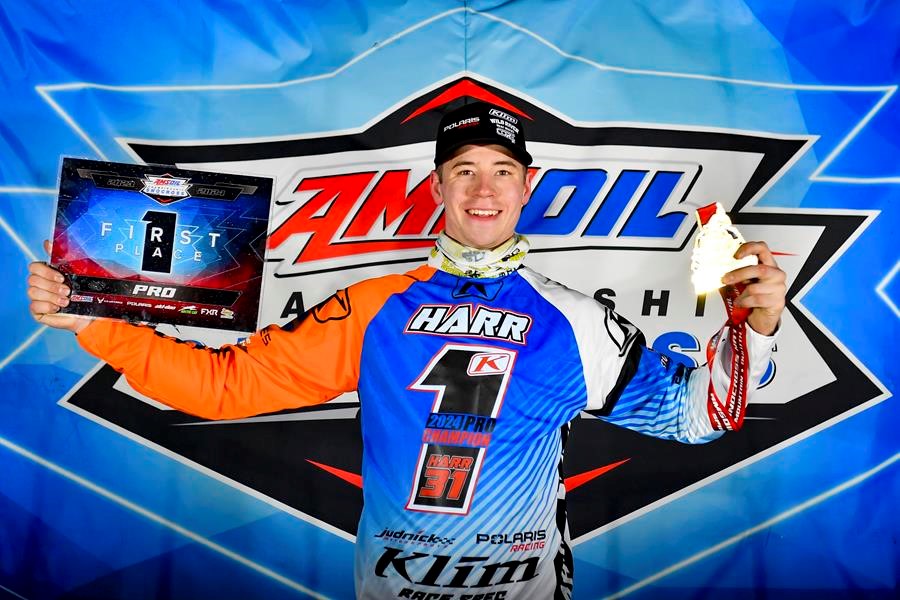
On the last weekend of April, the world of snowmobile snocross racing was shaken and stirred when affiliates at the snowmobile rules making body made a big change that affects the top class in which Tucker Hibbert, Kody Kamm, Tim Tremblay and other top pros compete.
Specifically, the affiliates who host snocross racing voted 5-0 (with one abstention) in the International Snowmobile Racing (ISR) rules making body to essentially eliminate the Pro Open class in favor of a new top class merely titled “Pro,” and to have the racers in that class compete on machines essentially identical to those on which Pro Lite racers compete.
What that means in actuality is that the race teams will no longer have the ability to build exotic race machines. Instead, the top racers will compete on so-called “stock” snowmobiles that must stay in the general form by which they were built by the sled factories in the engine, chassis and suspensions. Aftermarket silencers will allow the machines to be a little louder than stock, and on the Pro class sleds the headlights will be allowed to be shrouded. Aftermarket skis and shocks are also allowed.
Proponents of the rule stated that something must be done to take some costs out of racing – particularly after two teams that ran four Pro Open racers last year (Carlson Motor Sports and Leighton Motor Sports) pulled out of snocross for the 2017-18 season – and say the change will allow more Pro-Lite racers to step up into the top class. Opponents argue that those two teams didn’t pull out due to cost reasons, and say that the racing experience will be less interesting for fans, teams and drivers because of the change, and it will also stifle innovation.
That debate raged on social media and message boards for the past three weeks, so at Snow Goer we decided to let one person on each side of the situation make their case and let you decide, after reading both, how you feel.
Representing the side against the change is Steve Scheuring, owner and operator of the powerful Scheuring Speed Sports team that has been running the black Amsoil sleds on the national circuit for the past 20 years. Representing the side that asked for the change is Tom Rager Jr., the race manager at Polaris who similarly has a long history in the sport.
No matter which side of the argument you are on, we encourage you to read both interviews to gain further perspective – you might just change your mind on where you stand on this controversial topic!
The Q&A interviews are each rather long, but we told each person that we’d run the full interviews to let them make their case.
Click here for the Steve Scheuring interview, advocating a return to Pro Open rules.
Click here for the Tom Rager Jr. interview, advocating the case for the new rules that call for more stock-based equipment.







Ken Avann, the president of the Canadian Snowcross Racing Circuit in Canada, here.
It’s true, Pro Open will be replaced with a new “Pro” class: Here are some details:
All ISR affiliates have agreed to eliminate the Pro Open class. Pro racers will now compete with Pro-Lite Limited Build race sleds. Changes permitted include Aftermarket Silencers, Shocks, Skis, and Handlebars. The sled can also be reinforced and strengthened with added material.
This change is similar to Motocross racing where all competitors (Amateur and Pro) compete with limited build production race bikes all within a few horsepower of each other.
Benefits to this Change:
• All “Pro” racers will now compete on similar equipment permitting the team and racer with the most talent to win at any event in North America. The big dollar race teams no longer have a non attainable advantage over the independent racer.
• Racing will be tighter, speeds will be slightly less and safer.
• The change will encourage the OEM manufactures to build a better Limited Build race sled that all racers (Juniors, Sport, Pro-Lite & Pro) will benefit from.
• The cost to race in the new Pro class will be far less than the former Pro Open class.
• As Sport, Pro-Lite and Pro sleds are all similar, all parts are interchangeable reducing spare parts inventory.
• Race fuel for lower compression engines will be less expensive. Saving $2-3 thousand a year in fuel per racer.
• At the end of the season the sled can be sold to a Trail Sport, Novice, or Transition racer. A $5-7 thousand dollar return per sled to the racer or team..
• As the cost to race is less, the larger sponsored teams and manufactures could support more racers or provide better contingency programs.
• Pro and Pro-Lite racers use the same sleds so racers could now race in either class as approved by the specific race circuit.